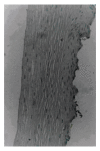pRB expression in esophageal mucosa of individuals at high risk for squamous cell carcinoma of the esophagus
- PMID: 17461478
- PMCID: PMC4146954
- DOI: 10.3748/wjg.v13.i11.1728
pRB expression in esophageal mucosa of individuals at high risk for squamous cell carcinoma of the esophagus
Abstract
Aim: To investigate the pRb expression in a large group of patients with history of chronic exposure to the main risk factors for development of squamous cell carcinoma of the esophagus.
Methods: One hundred and seventy asymptomatic individuals at high risk for esophageal squamous cell carcinoma (consumption of more than 80 g of ethanol and 10 cigarettes/d for at least 10 years) underwent upper gastrointestinal endoscopy with biopsies of the esophageal mucosa. As a control group, specimens of esophageal mucosa obtained from 20 healthy subjects were also studied. Immunohistochemical assessment of the tissues was performed using a monoclonal antibody anti-pRB protein.
Results: Absence of the pRB staining, indicating loss of RB function, was observed in 33 (19.4%) of the individuals at risk for esophageal cancer, but in none of the healthy controls (P < 0.02). Loss of pRb expression increased in a stepwise fashion according to the severity of the histological findings (P < 0.005): normal mucosa (11/97 or 11.3%), chronic esophagitis (17/60 or 28.3%), low-grade dysplasia (3/10 or 30%), high-grade dysplasia 1/2 or 50%) and squamous cell carcinoma (1/1 or 100%).
Conclusion: Our findings suggest that abnormal expression of the pRB protein may be implicated in the process of esophageal carcinogenesis. Additional studies are warranted to define the role of the pRB protein as a biomarker for development of esophageal squamous cell carcinoma in individuals at high risk for this malignancy.
Figures
References
-
- Parkin DM, Bray F, Ferlay J, Pisani P. Estimating the world cancer burden: Globocan 2000. Int J Cancer. 2001;94:153–156. - PubMed
-
- Ribeiro U, Posner MC, Safatle-Ribeiro AV, Reynolds JC. Risk factors for squamous cell carcinoma of the oesophagus. Br J Surg. 1996;83:1174–1185. - PubMed
-
- Kawakubo H, Ozawa S, Ando N, Kitagawa Y, Mukai M, Ueda M, Kitajima M. Alterations of p53, cyclin D1 and pRB expression in the carcinogenesis of esophageal squamous cell carcinoma. Oncol Rep. 2005;14:1453–1459. - PubMed
-
- Wiman KG. The retinoblastoma gene: role in cell cycle control and cell differentiation. FASEB J. 1993;7:841–845. - PubMed
-
- Hamel PA, Phillips RA, Muncaster M, Gallie BL. Speculations on the roles of RB1 in tissue-specific differentiation, tumor initiation, and tumor progression. FASEB J. 1993;7:846–854. - PubMed
MeSH terms
Substances
LinkOut - more resources
Full Text Sources
Medical
Research Materials



